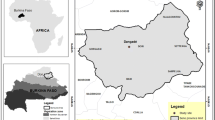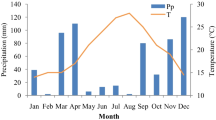Abstract
In view of the need to implement programs to recompose vegetation cover, urban afforestation, charcoal production, firewood production, and other wood or non-wood purposes, it is necessary to use alternatives and techniques that facilitate the production of seedlings in order to meet these demands, where water reuse is a promising alternative to ensure production at a reduced cost, without compromising the use of drinking water, without generating waste, potentiating the production process and promoting social and environmental benefits. Thus, it is necessary to adopt strategies to improve the efficiency of wastewater reuse for the production of forest species seedlings without compromising the initial growth of species. In this sense, the objective of this work was to evaluate the growth of Amburana cearensis plants in different substrates irrigated with industrial effluent. The study was conducted in a greenhouse in the city of Mossoró, state of Rio Grande do Norte. The experimental design was randomized blocks in a 2 × 5 factorial scheme, corresponding to two substrates and five effluent doses (0%, 25%, 50%, 75%, and 100%). The substrates used were soil with organic compost (S1) and soil with water hyacinth fiber (S2). Growth was evaluated by stem diameter (DC) and seedling height (H). Evaluations were performed every 15 days for 3 months. Absolute growth rate (AGR) and relative growth rate (RGR) were determined. Regression and correlation analysis was also performed. We found that the average stem diameter was larger for plants grown in the substrate with water hyacinth fibers (S2) and the average height was higher in the substrate with organic compost (S1). The RGR showed the same behavioral pattern in the control treatment at doses 25 and 50% in S1. In S2, the RGR for stem diameter decreased continuously with rising doses. The relative growth rates for height showed a tendency to decrease independently of treatments. Therefore, the seedlings showed good growth characteristics for all treatments and the 50% dose in S1 achieved the best results.



Similar content being viewed by others
Data availability
Does not apply.
References
Augusto DCC, Guerrini IA, Engel VL, Rousseau GX (2003) Use of domestic wastewater after biological treatment system for Croton floribundus Spreng. and Copaifera langsdorffii Desf. seedling production. Rev Árvore 27(3):335–342. https://doi.org/10.1590/S0100-67622003000300009
Benincasa MMP (2003) Análise de crescimento de plantas: noções básicas. 2nd. Jaboticabal: FUNEP
Brito RF, Ferreira Neto M, Morais MA, Dias NS, Lira RB (2018) Use of wastewater in the production of Aroeira seedlings. Rev Caatinga 31(3):687–694. https://doi.org/10.1590/1983-21252018v31n318rc
Cairo PAR, Oliveira LEM, Mesquita AC (2008) Análise de crescimento de plantas. Vitória da Conquista: Edições UESB
Carneiro JGA (1995) Produção e controle de qualidade de mudas florestais. Curitiba: UFPR/FUPEF
Empresa Brasileira de Pesquisa Agropecuária – EMBRAPA (2011) Manual de análise químicas de solos 2nd. Dados eletrônicos. Rio de Janeiro: Embrapa Solos
Gomes JM, Paiva HN (2011) Viveiros Florestais: Propagação sexuada. Viçosa: UFV
Grigio AM, Diodato MA (2011) Dimensões físicoambiental. In: Pessoa ZS, Grigio AM, Ferreira, LS, Clementino MLM (ed). Como anda Mossoró: análise da conjuntura sociourbana, ambiental e político-institucional. Natal: UFRN, pp 98-124
INMET, Estações Automáticas – Mossoró (2018) http://www.inmet.gov.br/portal/index.php?r=home/page&page=rede_estacoes_auto_graf. Accessed 19 Jun 2020
Lobo HLL, Silva TTS, Lima VLA, Medeiros SS, Monteiro DR (2014) Diagnostic socioeconomic and environmental settlement Venice, city of Aparecida, Paraíba/PB. Agrop Cient Semiárido 10(4):32–38. https://doi.org/10.30969/acsa.v10i4.488
Magalhães AG, Martins EL, Medeiros SS (2019) Growth analysis of mimosa caesalpiniaefolia Benth. irrigated with wastewater in semiarid region. Braz J Dev 5(12):28334–28342. https://doi.org/10.34117/bjdv5n12-019
Minhas PS, Yadav RK, Lal K, Chaturvedi RK (2015) Effect of long-term irrigation with wastewater on growth, biomass production and water use by Eucalyptus (Eucalyptus tereticornis Sm.) planted at variable stocking density. Agric Water Manag 152:151–160. https://doi.org/10.1016/j.agwat.2015.01.009
Morais ERC, Maia CE (2013) Shoot and root growth in the muskmelon when fertilised with organic fertiliser. Rev Ciênc Agron 44(3):505–511. https://doi.org/10.1590/S1806-66902013000300012
Najam-Us-Sahar, Azhar H, Ayesha M, Rashid W, Irfan A, Muhammad FUZA (2017) Effect of textile wastewater on growth and yield of wheat (Triticum aestivum L.). Soil Environ 36(1):28–34. https://doi.org/10.25252/SE/17/41133
Neves ALR, Lacerda CF, Oliveira AC, Sousa CHC, Oliveira FIF, Ribeiro MSS (2018) Quantitative and qualitative responses of Catharanthusroseus to salinity and biofertilizer. Rev Brasileira Engenharia Agríc Ambient 22(1):22–26. https://doi.org/10.1590/1807-1929/agriambi.v22n1p22-26
Nogueira AC, Medeiros ACS (2007) Coleta de sementes florestais nativas. Colombo: Embrapa Florestas. (Embrapa Florestas. Circular Técnica, 144)
Oliveira MKT, Dombroski JLD, Medeiros RCA, Tomczak VE, Farias RM (2016) Initial growth of Erythrina velutina in different substrates with organic fertilization. Rev Verde Agroecol Desenvolvimento Sustentável 11(5):30–38. https://doi.org/10.18378/rvads.v11i5.3594
Oliveira MM, Galvão EKS, Souza CLM, Boaventura VJ, Castro Neto MT, Oliveira LM, Pelacani CR (2019) Growth and split of the dry mass in young plants of amburana (Amburana cearensis (Fr. All.) AC Smith) and umbuzeiro (Spondias tuberosa Arr. Cam.). Ciência Florestal 29(3):1142–1153. https://doi.org/10.5902/1980509827189
Pinto JRS, Freitas RMO, Leite TS, Oliveira FA, Ferreira H, Leite MS (2016) Growthof Young Tabebuia aurea seed lingsunder irrigation with waste waterfrom fish farming. Rev Brasileira Engenharia Agríc Ambient 20(6):519–524. https://doi.org/10.1590/1807-1929/agriambi.v20n6p519-524
Rebouças JLR, Ferreira Neto M, Dias NS, Gomes JWS, Gurgel GCS, Queiroz ISR (2018) Quality of sabiá seedlings irrigated with domestic effluent. Rev Floresta 48(2):173–182. https://doi.org/10.5380/rf.v48i2.54366
Singh PK, Deshbhratar PB, Ramteke DS (2011) Effects of sewage wastewater irrigation on soil properties, crop yield and environment. Agric Water Manag 103:100–104. https://doi.org/10.1016/j.agwat.2011.10.022
Tarantino E, Disciglio G, Gatta G, Libutti A, Frabboni L, Gagliardi A, Tarantino A (2017) Agro-industrial treated wastewater reuse for crop irrigation: implication in Soil Fertilit. Chem Eng Trans 58:679–684. https://doi.org/10.3303/CET1758114
Tarchouna LG, Merdy P, Raynaud M, Pfeifer HR, Lucas Y (2010) Effects of long-term irrigation with treated wastewater. Part I: evolution of soil physico-chemical properties. Appl Geochem 25:1703–1710. https://doi.org/10.1016/j.apgeochem.2010.08.018
Zenginbal H, Okcu GD, Yalcuk A (2018) The impact of textile wastewater irrigation on growth and development of apple plant. Int J Phytoremediation 20(2):153–160. https://doi.org/10.1080/15226514.2017.1337076
Acknowledgements
The authors thank the Graduate Program in Environment, Technology, and Sociedade da Universidade Federal Rural do Semi-Árido, Brazil, and CAPES for research resources available. Maria Carolina Ramirez Hernandez, thanks CAPES, this study was financed in part by the Coordenação de Aperfeiçoamento de Pessoal de Nível Superior - Brasil (CAPES) - Finance Code 001.
Funding
This study was financed in part by the Coordenação de Aperfeiçoamento de Pessoal de Nível Superior - Brasil (CAPES) Finance Code 001.
Author information
Authors and Affiliations
Contributions
The article comes from LLBA’s master’s speech, not the Graduate Program in Environment, Technology, and Society of the Federal Rural University of Semi-Arid, Brazil. Our plan of work is to carry out the research on the part of the project diagnosis and quality of the semi-arid environment of Potiguar-Brazil, coordinated by Elís Regina Costa de Morais, counselor. ERCM and LLBA contributed to the planning and conducting of the experiment, as in the phase of evaluation of two data and writing of the manuscript. The other authors, JCAS (graduated from the graduate course in agronomy) and SJBF and MCRH (from the Graduate Program in Environment, Technology, and Society/UFERSA, Brazil), contributed to the phases of conducting the experiment, as in the phase of evaluation of two data and writing of the manuscript. In this sense, the authors declare that all participate equally in the elaboration of the manuscript
Corresponding author
Ethics declarations
Ethics approval and consent to participate
Research decorum does not involve human beings and animals; therefore, it does not apply.
Consent for publication
On behalf of Lívia Laiane Barbosa Alves, Josinaide Cláudia Araújo de Santana, Samantha Joyce Bezerra Faustino, and Maria Carolina Ramirez Hernandez, I, Elís Regina Costa de Morais, am submitting our article entitled “Growth of cumaru (Amburana cearensis) seedlings irrigated with industrial effluent.” The authors declare that they agree with the submission and eventual publication of the Environmental Science and Pollution Research.
Competing interests
The authors declare no competing interests.
Additional information
Responsible Editor: Gangrong Shi
The results of this research were sent only to that periodical.
Publisher’s note
Springer Nature remains neutral with regard to jurisdictional claims in published maps and institutional affiliations.
Rights and permissions
About this article
Cite this article
Alves, L.L.B., de Morais, E.R.C., de Santana, J.C.A. et al. Growth of cumaru (Amburana cearensis) seedlings irrigated with industrial effluent. Environ Sci Pollut Res 28, 20945–20953 (2021). https://doi.org/10.1007/s11356-021-13273-2
Received:
Accepted:
Published:
Issue Date:
DOI: https://doi.org/10.1007/s11356-021-13273-2




